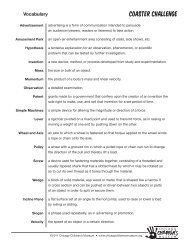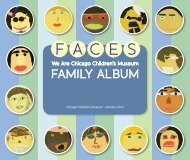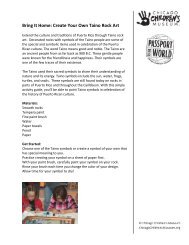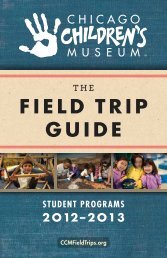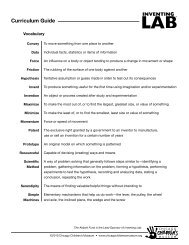Simple Machines Curriculum Guide - Chicago Children's Museum
Simple Machines Curriculum Guide - Chicago Children's Museum
Simple Machines Curriculum Guide - Chicago Children's Museum
Create successful ePaper yourself
Turn your PDF publications into a flip-book with our unique Google optimized e-Paper software.
small amount of motion as seen when the penny does not travel very far. In comparisonthrowing with a lot of force by using your whole arm, will result in more motion. When youthrow with your whole arm the penny will travel further.7. Set out a play parachute and a few soft balls. Have everyone gather around. Introduce gravity.8. Try moving just the parachute with a little force and then with a lot of force. Discuss how yousee the resulting motion as the parachute moves a little or a lot.9. Add a few balls to the center of the parachute. Ask students how they could use force to movethe balls. Try making the balls jump, making them roll in a circle or making them fall off theparachute altogether.10. Conclude by discussing how gravity and the force of the moving parachute made the ballsmove. Gravity pulled the balls down from the air. Force from the moving parachute made theballs fly up and down. The harder you flapped the parachute, i.e. the more force you applied,the farther the balls jumped into the air.● VariationHave students work in small groups to think of ways they use force while playing outside.● Homework/ Home ConnectionHave students make a list of three times they used force to push or pull something at home.Day 2● Time Allotment50 minutes● MaterialsMove It by Adrienne MasonShirt boxes or other shallow boxesWhite paper to fit in the bottom of boxesTempera PaintMarbles● Advance PreparationCut white paper to ensure it fits in the available boxes● Background InformationArt is a wonderful way to visually investigate force and motion. Painting requires using force tomove paint around a surface.We can see motion as an object moves from one spot to another. However, we don’t always have arecord of those motions. Painting not only uses forces, but also keeps a record of the paint’smovement across the surface of the paper.12 • Lesson 1: Introducing Force and Motion



